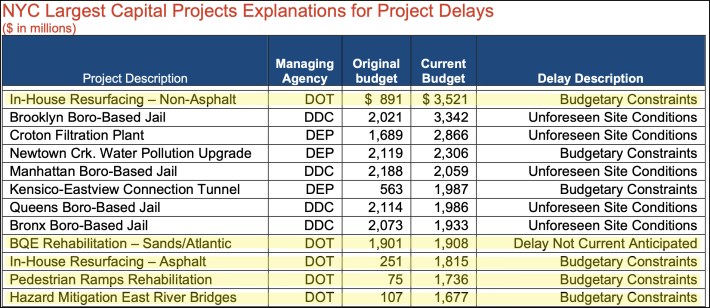Big budget city projects — including major ones inside the Department of Transportation — routinely blow past their budgets and completion dates due to, in part, poor monitoring, according to the State Comptroller.
In a new report, auditors working for Comptroller Tom DiNapoli reviewed more than 5,100 capital projects, and found that more than half had cost overruns.
The city DOT did not fare very well in the audit, with five big projects making DiNapoli's dirty dozen (though one is not seriously over-budget):

"A majority of analyzed projects are over both their initial budget and schedule, suggesting greater monitoring could lead to adjustments that ultimately improve capital project delivery," the report concludes.
The city has a "Capital Projects Detailed Data" dashboard that provides information about major projects — except according to DiNapoli's office, "the dashboard has not been updated since September 2023 and currently lacks details on initial project budgets and explanations for schedule delays that make it difficult to track progress."
Of the 5,128 projects, nearly 40 percent were more than 20 percent over-budget. Another 4 percent were 10 to 20 percent over-budget. The over-budget projects ended up costing 123.5 percent more than the original budget, or more than double, amounting to $54 million in waste. The 20 percent of the projects that came in under-budget saved the city $12 million.
It's hard for auditors to know what is causing the overruns or the delays. The city dashboard can cite 12 reasons for a delay, but few truly clarify, the report says. "Of the projects with a reported delay ... more than half are delayed because of 'budgetary constraints,' the auditors wrote. "Budgetary constraints are not clearly defined but may be due to a lack of capital funding in the city treasury at points during the project life or needed changes to funding commitments made in the Capital Commitment Plan. ... For the remaining projects experiencing a delay, the most common reasons are changes to scope and design, and an unforeseen site or field condition."
DiNapoli's report missed many projects listed by the DOT in the city's capital dashboard, perhaps because each project is broken up into many budget lines across multiple fiscal years.
For instance, Streetsblog reviewed all DOT capital projects in the dashboard since June 30, 2020 (aka when fiscal year 2021 began) and discovered 4,888 projects ranging in original budget prediction from $350 to $1,901,292.
Those projects had an overall predicted budget of $159,929,150 and an overall total cost of $188,994,285 — or a cost overrun of 18 percent, though that's a conservative estimate because some projects are ongoing.
Of the 100 biggest projects, ranging in original budget cost of $269,368 to $1.9 million, the total budget prediction was $58,531,235, but swelled to $65,515,418, or an overrun of 12 percent, though again some projects are ongoing.
Among those 21 projects were some that DiNapoli's report missed:
- Ten line items for part of the Broadway Bridge approach roads rehabilitation: Original city budget of $367,460 swelled to $1,457,247 or a 296-percent increase.
- Ten capital line items for construction of ferry boats: Original city budget of $3,400,000 swelled to $5,857,656, an increase of 72 percent.
- Two line items for repairs of Brooklyn Bridge ramps: Original city budget of $3,000,000 swelled to $4,349,768 or an increase of 45 percent.
DOT declined to comment on any specifics, but disputed DiNapoli's reference to the projects in his report as "capital" work when such things as "in-house" road resurfacing are ongoing projects that don't have budgetary constraints — in fact, the more road resurfacing the city does, the more money it spends.
The agency also disputed how the state bean counter counted their beans.
“DOT’s resurfacing and pedestrian ramp work listed are annual and ongoing in-house projects — there are no budgetary constraints or significant delays," agency spokesman Vin Barone said. "The underlying data used for this report is based on an outdated and overly technical way of looking at these projects, and that is why some in-house, regularly reoccurring maintenance and rehabilitation work is listed with regular payments technically reflected as project budget increases.”
He added that the city is transitioning to a "more holistic" system that will review the entire lifecycle of projects, and that words like "original budget" or "cost overruns" can be misleading because such numbers could simply reflect how much capital money an agency has at any given time.
City Comptroller Brad Lander jumped all over the Adams administration's delays in updating the capital dashboard.
"As Comptroller DiNapoli’s report lays out, a dashboard is only as good as the data that powers it, and this one is already woefully out of date," he said in a statement.






